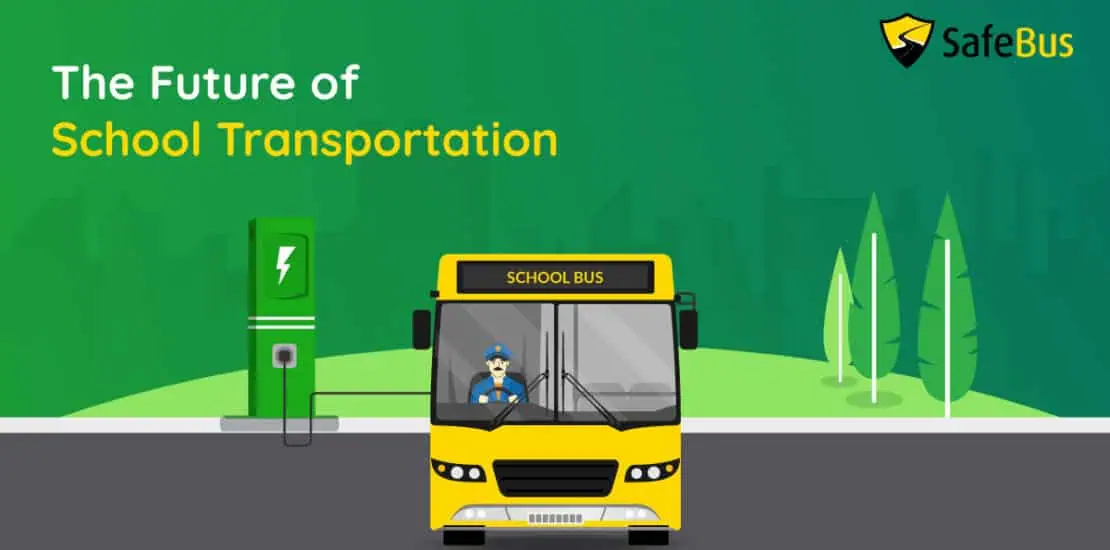- August 1, 2024
- Posted by: SafeBus Marketing
- Category: Blog

The landscape of school transportation is evolving rapidly, driven by technological advancements and increasing awareness of environmental and safety concerns. From rising transportation costs to environmental impacts and inefficient route planning, schools face a complex array of issues that demand innovative solutions.
In this blog, we will explore the current challenges in school transportation and emerging trends and innovations that promise to reshape the future of school transportation.
Interesting ReadWhy are School Buses Yellow? – A Sneak Peak in the HistoryThe Father of the Yellow School Bus – Frank W. Cyr, Professor of Rural Education, Teachers College, Columbia University standardized the bright yellow color for school bus to improve safety in 1939. The color was selected from 50 different swatches because of its high visibility and sensitivity towards the human eye. |
Current Challenges in School Transportation
1. Safety Concerns
Student safety is a top priority for schools. Ensuring that students are transported safely to and from school is a significant responsibility. Parents and school staff are struggling to ensure that their kids travel safely with an increasing number of road accidents and irresponsible driving behavior.
2. Rising Transportation Costs
Operating a school transportation system involves significant expenses, including rising fuel prices, regular vehicle maintenance, staff salaries, and more. All this adds to transportation costs and may burden schools financially.
3. Environmental Impact
Traditional school buses powered by diesel fuel contribute to environmental pollution. With growing concerns about climate change and air quality, there is increasing pressure to adopt greener transportation solutions.
4. Inefficient Route Planning and Management
Inefficient route planning leads to longer travel times, higher fuel consumption, and increased operational costs. Poorly planned routes can also result in delays, affecting students’ punctuality and overall transportation experience.
Future of School Transportation: Emerging Trends & Innovations
1. Electric School Buses
Electric school buses represent a significant shift towards sustainable transportation. Unlike diesel buses, electric buses produce zero emissions, contributing to cleaner air and a healthier environment. They also offer quieter operations, reducing noise pollution in communities.
2. Improved Safety Features
The future of school transportation will see a rise in the adoption of advanced surveillance systems. Cameras and live monitoring systems for location tracking can help ensure student safety. These systems also provide valuable evidence in case of incidents.
Additionally, emergency response systems will play a crucial role too. Real-time communication tools and SOS buttons can enable drivers and bus attendants to quickly alert authorities in case of an emergency.
3. Advanced Automation Tracking Solutions
Leverage automation by implementing school bus management systems to have a 360-degree view of transport operations. From route planning to tracking to attendance management digitize everything to achieve operational efficiency. This will help schools save resources and focus on growth.
4. Driver Behavior Monitoring
Monitoring driver behavior is essential for ensuring safe and efficient transportation. Advanced telematics systems can track driving patterns, such as speeding, harsh braking, and idling. By analyzing this data, schools can provide targeted training to promote safe driving practices, ultimately reducing accidents and improving fuel efficiency.
5. Mobile Apps
Mobile apps are becoming an integral part of modern school transportation systems. These apps for parents and attendants offer real-time tracking, route updates, and notifications, keeping parents and school staff informed. For example, parents can receive alerts when the bus is approaching their child’s stop, ensuring timely pickups and drops.
6. Leveraging Data Analytics
Data analytics can revolutionize how school transportation is managed. By collecting and analyzing data on routes, fuel consumption, and vehicle performance, schools can identify inefficiencies and implement improvements. These can also help anticipate maintenance needs, reducing downtime and extending the lifespan of vehicles.
7. Community Involvement
Community involvement is crucial for the success of any school transportation initiative. Schools must organize workshops and meetings to gather input from parents and community members, ensuring that their needs and concerns are addressed. Involving the community fosters a sense of ownership and support for transportation programs.
Conclusion
As we move forward, schools need to embrace these innovations and stay proactive in implementing new strategies. Investing in the future of school transportation benefits the environment and ensures a safer, more efficient, and enjoyable experience for students. By prioritizing innovation and sustainability, we can pave the way for a better, more connected future for school transportation.
Connect with SafeBus to transform your school bus operations.

